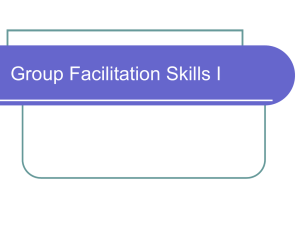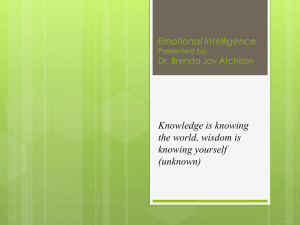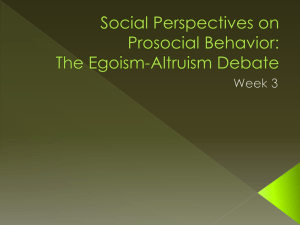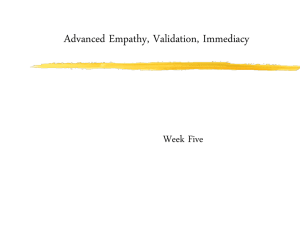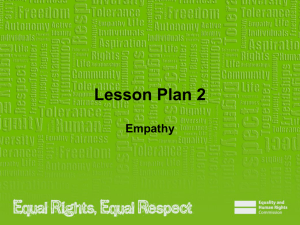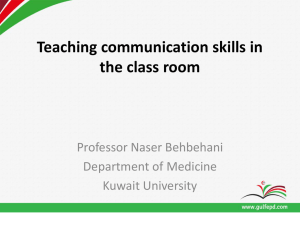empathy towards people with intellectual disabilities
advertisement
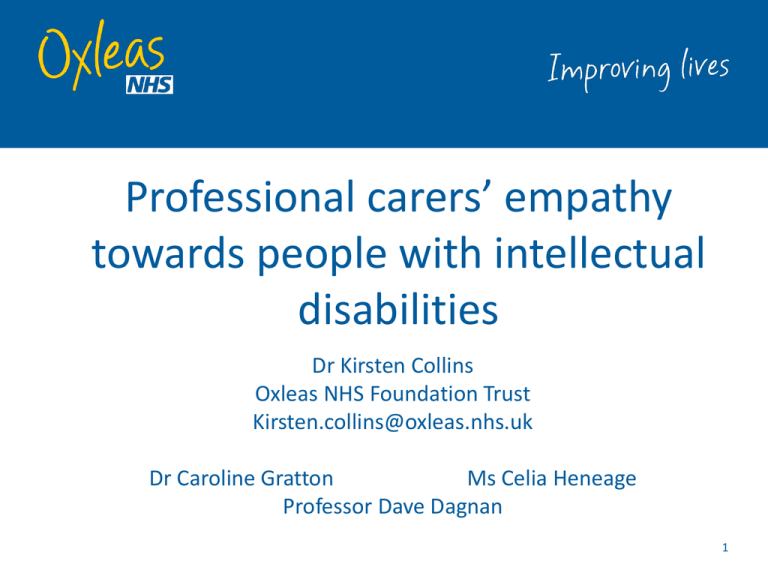
Professional carers’ empathy towards people with intellectual disabilities Dr Kirsten Collins Oxleas NHS Foundation Trust Kirsten.collins@oxleas.nhs.uk Dr Caroline Gratton Ms Celia Heneage Professor Dave Dagnan 1 A quick guide to empathy • Cognitive vs. affective empathy • Strong evidence that empathy… a) influences caregiving/helping- Batson’s empathyaltruism hypothesis. b) is associated with improved health & social care outcomes. Carer empathy is important • People with intellectual disabilities (‘service users’) value empathy (Clarkson et al. 2009; Dinsmore & Higgins, 2011; Roeden et al. 2011) • Staff offer key emotional support (Forrester-Jones et al. 2006) given small relationship networks. Relationships with staff become important (McVilly et al. 2006). • Winterbourne: carer values in preventing abuse • Difficulty communicating internal world = reliance on carers using empathy to interpret needs & feelings. Empathy associated with attachment security (Mikulincer & Shaver, 2007) & Bowlby’s (1982) mental representations of caregiving (Reizer & Mikulincer, 2007). Attachment style influences caring interactions with service users (Schuengel et al. 2012). Could empathy link situational and dispositional models of caregiving behaviour? Attribution theory (Weiner, 1980) applied to challenging behaviour: mixed evidence. Strongest correlation between sympathy & helping (e.g. Dagnan & Cairns, 2005). Could empathic stance increase model’s predictive power (based on Betancourt, 1990)? A new empathy measure Aims • Develop a new measure of carers’ empathy towards people with intellectual disabilities. • What does this say about the nature of empathy towards service users? Measure development • “What comes to mind when you think of professional carers’ empathy towards people with an intellectual disability?” • 31 responses → Thematic analysis → 12 themes → 60 items • Experts rated items → 28 item draft questionnaire • Pilot study → minor language adjustments • 5 questionnaires to 800 staff (194 returned, 13 employers, 74% female) Quantitative study 1. EMP-ID (the new measure) 2. Demographics and nature of work 3. Interpersonal Reactivity Index (IRI): dispositional empathy measure -contains cognitive and affective subscales 4. Mental Representations of Caregiving Scale (MRC) -perceived ability to recognise others’ needs -appraisal of others as worthy of help -perceived ability to provide effective help -altruistic and egoistic motivations for helping 5. Marlowe-Crown Social Desirability Scale (SDS) Exploratory factor analysis • Two stage factor analysis → 21 item scale with a 3-factor structure • Proximity: sense of psychological closeness and of having shared/common psychological experiences to people with intellectual disabilities. • Active attunement: deliberate effort to tune in to service users’ internal worlds • Challenge: whether it feels difficult to empathise with service users. • All loadings > 0.32 (minimum to claim loading) • Majority of loadings > 0.45 = ‘fair’ Psychometrics Support for construct validity 1. Highly significant correlations (i.e. many at 0.001 sig. level) with MRC subscales. Pattern of correlations supports our interpretation of factors. 2. Significant correlations (mainly at 0.01 sig. level) with IRI subscales. 3. Some factors relate to gender and whether pps know a person with an intellectual disability outside work. Subscales have acceptable internal (0.73≤ α ≥0.76) and test-retest (0.56≤ r ≥0.86) reliability. What does this mean? • Factors do not map to the cognitive/affective structure. • Factors fit with other empathy research 1. Proximity/ imagine self/ similarity cluster 2. Active attunement/ imagine other/ nurturance cluster • Logical that similarity and nurturance become salient when the ‘subject’ of empathy has an intellectual disability • Challenge: how easy it is to actively attune Conclusions Cognitive and affective processes are not the most salient feature Instead… Empathising with people with intellectual disabilities exacerbates particular processes used in empathising more generally: a) carers’ sense of themselves as psychologically similar, and willingness to be psychologically close, to people with an intellectual disability (proximity). b) carers’ active efforts to tune in to people with intellectual disabilities’ internal worlds (active attunement). Study gives evidence that carers’ mental representations of caregiving relate to their empathy towards service users. Some limitations • A self-report measure • Accounts for 34% variance i.e. other unmeasured influences on empathy. • Challenge items all negatively worded: did they cluster because of wording? • Correlations are highly significant but weak i.e. small effects. • Variance in Active Attunement scores could result from individual differences in tendency to respond in a socially desirable manner. • 25% response rate i.e. do findings generalise if very empathic carers participated? Future research • How does self-reported empathy relate to actual feelings/demonstrations of empathy ? • Clarification of the nature & determinants of the empathy clusters. • How do attachment styles influence carers’ empathy & caregiving behaviour? • Does an empathic stance influence attributions, emotions and helping behaviour towards PWID? • How can organisations can help carers maintain empathy? Implications Care providers Psychologists •Consider job applicants’ empathy •Exercises/therapy/reflective practice to increase use of empathy skill clusters •Organisational ethos: attuning is valuable •Attachment representations are likely to influence empathy and caregiving for service users. Enhance ‘felt’ security e.g. regular, reflective supervision with a consistent supervisor & work in one location. •Explore impact of beliefs that empathising with service users is challenging •Recognised empathy interventions e.g. internalised-other, mentalization. •Help providers to enhance ‘felt’ security via consultancy on how providers enhance security or training/supervision to managers within care organisations A (partial) recipe for empathy? … a secure base hierarchy … empathising-understood reciprocal roles? Person with an intellectual disability ‘Felt secure’ staff team, being empathic to a… ‘Felt secure’ LDT & psychologists, being empathic to a… Politically stable NHS Trust, supporting and being mindful of a… Questions, comments, reflections…

